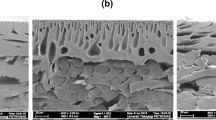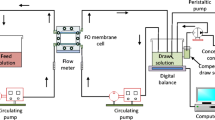Abstract
This study was conducted to assess the merits and limitations of various high-pressure membranes, tight nanofiltration (NF) membranes in particular, for the removal of trace organic compounds (TrOCs). The performance of a low-pressure reverse osmosis (LPRO) membrane (ESPA1), a tight NF membrane (NF90) and two loose NF membranes (HL and NF270) was compared for the rejection of 23 different pharmaceuticals (PhACs). Efforts were also devoted to understand the effect of adsorption on the rejection performance of each membrane. Difference in hydrogen bond formation potential (HFP) was taken into consideration. Results showed that NF90 performed similarly to ESPA1 with mean rejection higher than 95%. NF270 outperformed HL in terms of both water permeability and PhAC rejection higher than 90%. Electrostatic effects were more significant in PhAC rejection by loose NF membranes than tight NF and LPRO membranes. The adverse effect of adsorption on rejection by HL and ESPA1 was more substantial than NF270 and NF90, which could not be simply explained by the difference in membrane surface hydrophobicity, selective layer thickness or pore size. The HL membrane had a lower rejection of PhACs of higher hydrophobicity (log D>0) and higher HFP (>0.02). Nevertheless, the effects of PhAC hydrophobicity and HFP on rejection by ESPA1 could not be discerned. Poor rejection of certain PhACs could generally be explained by aspects of steric hindrance, electrostatic interactions and adsorption. High-pressure membranes like NF90 and NF270 have a high promise in TrOC removal from contaminated water.

Similar content being viewed by others
References
Benotti MJ, Trenholm R A, Vanderford B J, Holady J C, Stanford B D, Snyder S A. Pharmaceuticals and endocrine disrupting compounds in U.S. drinking water. Environmental Science & Technology, 2009, 43(3): 597–603
Jin X, Hu J. Role of water chemistry on estrone removal by nanofiltration with the presence of hydrophobic acids. Frontiers of Environmental Science & Engineering, 2015, 9(1): 164–170
Geise G M, Paul D R, Freeman B D. Fundamental water and salt transport properties of polymeric materials. Progress in Polymer Science, 2014, 39(1): 1–42
Wang X, Yang H, Li Z, Yang S, Xie Y. Pilot study for the treatment of sodium and fluoride-contaminated groundwater by using highpressure membrane systems. Frontiers of Environmental Science & Engineering, 2015, 9(1): 155–163
Doederer K, Farré M J, Pidou M, Weinberg H S, Gernjak W. Rejection of disinfection by-products by RO and NF membranes: influence of solute properties and operational parameters. Journal of Membrane Science, 2014, 467(1): 195–205
Kimura K, Amy G, Drewes J E, Heberer T, Kim T U, Watanabe Y. Rejection of organic micropollutants (disinfection by-products, endocrine disrupting compounds, and pharmaceutically active compounds) by NF/RO membranes. Journal of Membrane Science, 2003, 227(1): 113–121
Radjenovic J, Petrovic M, Ventura F, Barceló D. Rejection of pharmaceuticals in nanofiltration and reverse osmosis membrane drinking water treatment. Water Research, 2008, 42(14): 3601–3610
Comerton A M, Andrews R C, Bagley D M, Hao C. The rejection of endocrine disrupting and pharmaceutically active compounds by NF and RO membranes as a function of compound and water matrix properties. Journal of Membrane Science, 2008, 313(1): 323–335
Bellona C, Drewes J E, Xu P, Amy G. Factors affecting the rejection of organic solutes during NF/RO treatment: a literature review. Water Research, 2004, 38(12): 2795–2809
Kong F X, Yang H W, Wang X M, Xie Y F. Assessment of the hindered transport model in predicting the rejection of trace organic compounds by nanofiltration. Journal of Membrane Science, 2015, 498: 57–66
Wang X, Li B, Zhang T, Li X Y. Performance of nanofiltration membrane in rejecting trace organic compounds: experiment and model prediction. Desalination, 2015, 370: 7–16
Dong L, Huang X,Wang Z, Yang Z,Wang X, Tang C Y. A thin-film nanocomposite nanofiltration membrane prepared on a support with in situ embedded zeolite nanoparticles. Separation and Purification Technology, 2016, 166: 230–239
Verliefde A R D, Cornelissen E R, Heijman S G J, Hoek E M V, Amy G L, Van der Bruggen B, Van Dijkt J C. Influence of solutemembrane affinity on rejection of uncharged organic solutes by nanofiltration membranes. Environmental Science & Technology, 2009, 43(7): 2400–2406
Mahlangu T, Schoutteten K, D’Haese A, Van den Bussche J, Vanhaecke L, Thwala J, Mamba B, Verliefde A. Role of permeate flux and specific membrane-foulant-solute affinity interactions (Δ Gslm) in transport of trace organic solutes through fouled nanofiltration (NF) membranes. Journal of Membrane Science, 2016, 518: 203–215
Steinle-Darling E, Litwiller E, Reinhard M. Effects of sorption on the rejection of trace organic contaminants during nanofiltration. Environmental Science & Technology, 2010, 44(7): 2592–2598
Israelachvili J N. Intermolecular and Surface Forces. San Francisco: Academic Press, 2015
Nghiem L D, Schäfer A I. Adsorption and transport of trace contaminant estrone in NF/RO membranes. Environmental Engineering Science, 2002, 19(6): 441–451
Schäfer A I, Akanyeti I, Semião A J C. Micropollutant sorption to membrane polymers: a review of mechanisms for estrogens. Advances in Colloid & Interface Science, 2011, 164(S1–2): 100–117
Nghiem L D, Schäfer A I, Elimelech M. Removal of natural hormones by nanofiltration membranes: measurement, modeling, and mechanisms. Environmental Science & Technology, 2004, 38 (6): 1888–1896
Shah A D, Huang C H, Kim J H. Mechanisms of antibiotic removal by nanofiltration membranes: model development and application. Journal of Membrane Science, 2012, 389: 234–244
Dolar D, Vukovic A, Ašperger D, Kosutic K. Effect of water matrices on removal of veterinary pharmaceuticals by nanofiltration and reverse osmosis membranes. Journal of Environmental Sciences-China, 2011, 23(8): 1299–1307
Hoek E M, Elimelech M. Cake-enhanced concentration polarization: a new fouling mechanism for salt-rejecting membranes. Environmental Science & Technology, 2003, 37(24): 5581–5588
Plakas K, Karabelas A, Wintgens T, Melin T. A study of selected herbicides retention by nanofiltration membranes—the role of organic fouling. Journal of Membrane Science, 2006, 284(1): 291–300
Semião A J, Schäfer A I. Estrogenic micropollutant adsorption dynamics onto nanofiltration membranes. Journal of Membrane Science, 2011, 381(1): 132–141
Kong F X, Yang H W, Wu Y Q, Wang X M, Xie Y F. Rejection of pharmaceuticals during forward osmosis and prediction by using the solution–diffusion model. Journal of Membrane Science, 2015, 476 (476): 410–420
Bowen W R, Welfoot J S. Modelling the performance of membrane nanofiltration—critical assessment and model development. Chemical Engineering Science, 2002, 57(7): 1121–1137
Kim S D, Cho J, Kim I S, Vanderford B J, Snyder S A. Occurrence and removal of pharmaceuticals and endocrine disruptors in South Korean surface, drinking, and waste waters. Water Research, 2007, 41(5): 1013–1021
Ventresque C, Gisclon V, Bablon G, Chagneau G. An outstanding feat of modern technology: the Mery-sur-Oise Nanofiltration Treatment Plant (340,000 m3/d). Desalination, 2000, 131(1): 1–16
Freger V, Gilron J, Belfer S. TFC polyamide membranes modified by grafting of hydrophilic polymers: an FT-IR/AFM/TEM study. Journal of Membrane Science, 2002, 209(1): 283–292
Liang L, Zhang J, Feng P, Li C, Huang Y, Dong B, Li L, Guan X. Occurrence of bisphenol A in surface and drinking waters and its physicochemical removal technologies. Frontiers of Environmental Science & Engineering, 2015, 9(1): 16–38
Redding A M, Cannon F S, Snyder S A, Vanderford B J. A QSARlike analysis of the adsorption of endocrine disrupting compounds, pharmaceuticals, and personal care products on modified activated carbons. Water Research, 2009, 43(15): 3849–3861
Nghiem L D, Schäfer A I, Elimelech M. Pharmaceutical retention mechanisms by nanofiltration membranes. Environmental Science & Technology, 2005, 39(19): 7698–7705
Yangali-Quintanilla V, Sadmani A, McConville M, Kennedy M, Amy G. Rejection of pharmaceutically active compounds and endocrine disrupting compounds by clean and fouled nanofiltration membranes. Water Research, 2009, 43(9): 2349–2362
SchäferA I, Waite T D, Fane A G. Nanofiltration: Principles and Applications. Amsterdam: Elsevier, 2005, 121–122
Tang C Y, Kwon Y N, Leckie J O. Effect of membrane chemistry and coating layer on physiochemical properties of thin film composite polyamide RO and NF membranes: I. FTIR and XPS characterization of polyamide and coating layer chemistry. Desalination, 2009, 242(1–3): 149–167
Acknowledgements
We acknowledge the funding for this research provided by the National Natural Science Foundation of China (Grant No. 51678331) and the special funding of State Key Joint Laboratory of Environment Simulation and Pollution Control, Tsinghua University (No. 15Y01ESPCT).
Author information
Authors and Affiliations
Corresponding author
Electronic supplementary material
Rights and permissions
About this article
Cite this article
Zhao, Yy., Kong, Fx., Wang, Z. et al. Role of membrane and compound properties in affecting the rejection of pharmaceuticals by different RO/NF membranes. Front. Environ. Sci. Eng. 11, 20 (2017). https://doi.org/10.1007/s11783-017-0975-x
Received:
Revised:
Accepted:
Published:
DOI: https://doi.org/10.1007/s11783-017-0975-x




